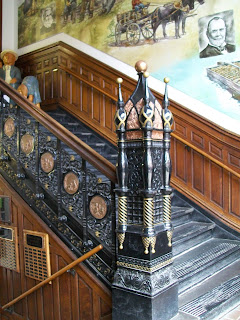Former depot for the Oil Creek & Titusville Railroad.
Sidewalk grate in Oil City, PA.
In 1859, Colonel Drake struck oil near present-day Titusville, Pennsylvania, sparking a worldwide rush for black gold. The discovery created a frenzy of building and exploitation. Smack in the middle of western Pennsylvania forest land, you'll find incongruous examples of Gilded Age architecture set against a backdrop of rugged mountainsides and rural rivers.
Back in the day, towns like Oil City sprouted out of the rural valleys to keep pace with the riches being pumped from the ground. John D. Rockefeller and others like him built spectacular buildings to house their empires. At one time, Pennzoil, Wolf's Head and Quaker State all headquartered here in Oil City.


They're all gone now. Oil City is left with a wealth of beautiful buildings and no industry to inhabit them. They are making good headway however, in turning their building assets into an artist colony.While oil shale is making news again in parts of the state, Oil City is attracting residential artists by offering attractive live/work options for working artists. The Oil Valley Center for the Arts offers classes and demonstrations in the historic Transit Building, where the gorgeous oak woodwork and marble floors create a dramatic backdrop for galleries.




Examining the connection between variety of playing codecs engaged in frequently and money spent prior to now 12 months on playing, the connection was weak (− 0.20, 95% CI, -0.22, − 0.17). The relationship between frequency of playing prior to now 12 months and involvement was reasonable (0.forty, 95% CI, 0.38–0.43). While not sturdy, these results recommend that playing involvement is positively 원 엑스 벳 related to playing intensity. Figure3 illustrates the overall percentage of people experiencing a playing drawback and people not experiencing a playing drawback across variety of playing codecs. Among people not experiencing a playing drawback, 45% gamble on just one format, whereas among people experiencing a playing drawback, 16% gamble on just one format. Among people not experiencing a playing drawback, as the variety of monthly playing codecs increases, the proportion decreases, with less than 8% participating in 4 or more playing codecs on a monthly basis.
ReplyDeleteMy home town!
ReplyDelete